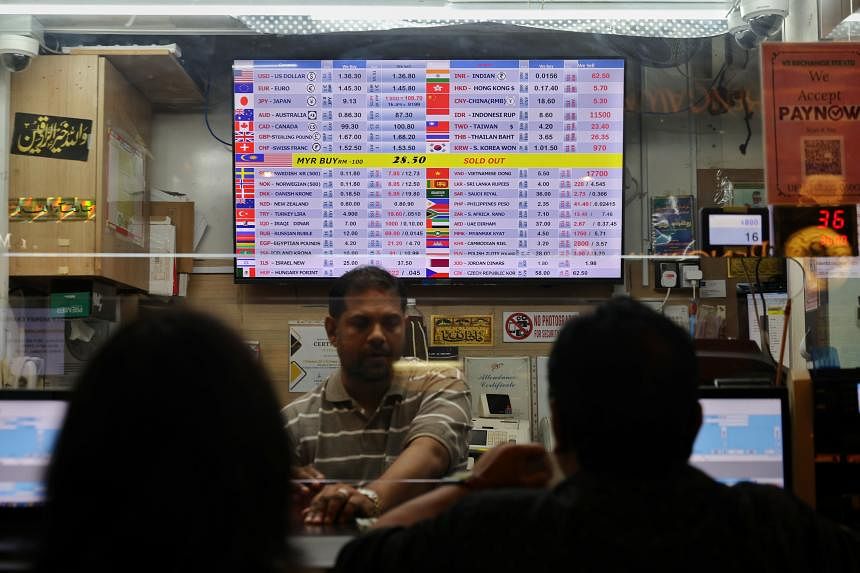SINGAPORE – The Singapore dollar surged to a new high of 3.5086 against the Malaysian ringgit early on Tuesday morning.
The exchange rate first breached the 3.5 mark at 10.21pm on Monday, according to Bloomberg data. The rate then fluctuated but was largely floating above 3.5 overnight until 9.05am on Tuesday.
The spot price fell to 3.4987 at 9.06am before going above 3.5 again at 10.13am on Tuesday. As at 6pm, it was trading at 3.5023.
VS Money Changer director Tajdeen Vanchilabbai said: “The ringgit has been going down gradually over the past one to two weeks now, and our customers have been buying the currency regularly each time it drops, thinking it is the lowest it can go.”
Although he did not expect a big spike in the number of customers at his shop on Tuesday, demand was high, and his supply sold out by about 3.30pm.
At least five other money changers in the same building, The Arcade in Raffles Place, ran out of ringgit at 5pm. Most of them were selling the Singdollar at a rate of RM3.47 to RM3.48.
The weaker ringgit is welcome news to Malaysians working in Singapore, especially those who are remitting money home, like sales executive Eugene Wong, 23.
Mr Wong, who is from Cameron Highlands and has been working in Singapore for two years, said: “The money I send back every two to three months can cover a larger portion of my sibling’s school fees, some investments and household allowances for my parents.”
Information technology manager Z.Y. Lim, 30, from Kuala Lumpur, feels “shiok” when his income in Singdollars can be exchanged for more ringgit, as he can afford to “add more dishes to his economy rice in Malaysia”.
But he added that the new rate is a small perk and will not help reduce his family’s cost of living, especially after subsidy cuts and tax increases are introduced in Malaysia in 2024.
Singaporean Aloysius Ho, 28, who has travelled to Johor Bahru six times since January, said if the ringgit continues to slide against the Singdollar, he might visit Malaysia more often.
Mr Kelvin Lam, the chief operating officer at YouTrip – a multi-currency digital platform – said he has seen a steady increase in users’ spending in ringgit since the start of the year.
The Singdollar-ringgit currency pair was trading at 3.2743 at the beginning of 2023, according to Bloomberg data.
“We saw a 78 per cent increase in total Malaysian ringgit spending made by YouTrip users in the last quarter, compared with the first quarter of 2023,” said Mr Lam.
He said YouTrip expects the transaction volume to continue rising, “with a projection to hit close to threefold of last year’s by the end of 2023”.
Ms Ashley Thomas, head of operations at fintech firm Revolut Singapore, said there has been an increase in remittances from Singapore to Malaysia, as well as Singaporeans spending in Malaysia, especially at the weekend.
Remittances to Malaysia increased by more than 20 per cent year on year in the first quarter of 2023, she said, while payment volumes were up 30 per cent in the second quarter of 2023, compared with the first quarter.
She said: “With the upcoming year-end holidays approaching and the ringgit reaching a low against the Singdollar, we expect an even stronger demand for MYR.”
Bank of Singapore currency strategist Sim Moh Siong said the rising US interest rate has been exerting pressure on the ringgit, and that has driven the ringgit lower. It did not help with Malaysia’s sliding exports amid a global slowdown.
Mr Sim said: “The weakness of the ringgit is likely to benefit the exporters. But at the same time, when the exporters sell their goods and get their US dollar receipt, they are probably happy to keep the dollar at this point in time, given the high interest rate relative to high Malaysian interest rates.”
Bank Negara Malaysia said in June that it would intervene in the foreign exchange markets to stabilise the ringgit.
Mr Sim said while direct intervention by the central bank is a possible policy option, “Malaysia’s relatively low foreign reserves buffer is a constraint”.
This means the ringgit could continue to weaken in the near term, he added.


